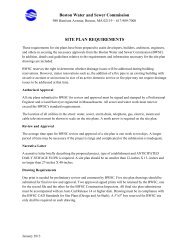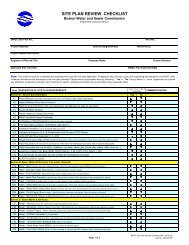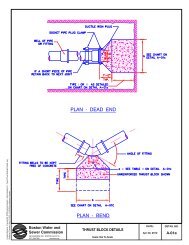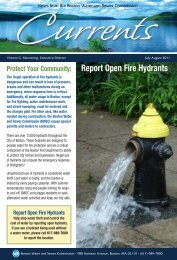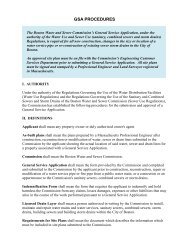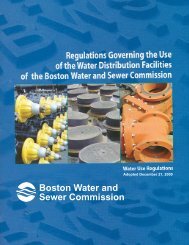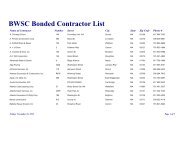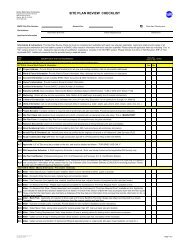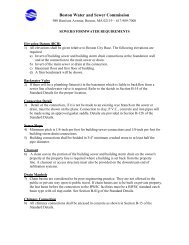2010 Stormwater Management Report (PDF) - US Environmental ...
2010 Stormwater Management Report (PDF) - US Environmental ...
2010 Stormwater Management Report (PDF) - US Environmental ...
Create successful ePaper yourself
Turn your PDF publications into a flip-book with our unique Google optimized e-Paper software.
a. Privately Owned Retention/Infiltration Devices<br />
On-site retainage and infiltration of stormwater is required for new and redevelopment<br />
projects, whenever site conditions permit, as determined by the Commission. Project<br />
developers are required to include a feasibility assessment for on-site retention of<br />
stormwater with the site plan submitted to the Commission for the project. On-site<br />
retention of stormwater serves to limit peak discharge rates, recharge groundwater, and<br />
remove 80 percent of total suspended solids in the flow to the extent feasible. This<br />
requirement is consistent with the Department of <strong>Environmental</strong> Protection’s <strong>Stormwater</strong><br />
<strong>Management</strong> Policy which establishes standards for stormwater management for<br />
development.<br />
On-site retention devices are usually owned by the owner of the property where they are<br />
located, and the owner is responsible for cleaning and maintenance. Owners of on-site<br />
devices are not required to provide data regarding solids removal rates to the<br />
Commission. However, the devices are expected to remove solids consistent with their<br />
designs.<br />
In <strong>2010</strong>, the Commission approved 185 site plans which included installation of a dry<br />
well or other type of infiltration device. The addresses of the devices approved in <strong>2010</strong><br />
were listed previously in Table 3 – 4. Since 1993, when the Commission first started<br />
tracking infiltration devices installed pursuant to site plans, 1,476 private development<br />
projects have included infiltration devices.<br />
b. Privately Owned Particle Separators<br />
In order to prevent oil, grease and sediments from discharging to open waterways, the<br />
Commission requires that developers install particle separators on all newly constructed<br />
storm drains that serve outdoor paved areas of 7,500 square feet in size or greater. The<br />
Commission ensures that particle separators on parking lots are included in the project<br />
design during site plan review. The Commission may require particle separators on<br />
existing storm drains from existing outdoor parking areas, where appropriate. This<br />
requirement has been in place since 1992.<br />
Parking lot particle separators are usually owned by the owner of the property where they<br />
are located, and the owner is responsible for their cleaning and maintenance. Owners of<br />
on-site particle separators are not required to provide data regarding solids removal rates<br />
to the Commission. However, the devices are expected to remove solids consistent with<br />
their designs.<br />
In <strong>2010</strong>, the Commission approved 24 site plans which included installation of particle<br />
separators. The addresses of the devices approved in <strong>2010</strong> were previously listed on<br />
Table 3 – 5. Since 2001, when the Commission first started tracking particle separators<br />
installed pursuant to site plans, 256 private development projects have included<br />
installation of particle separators.<br />
8- 2



